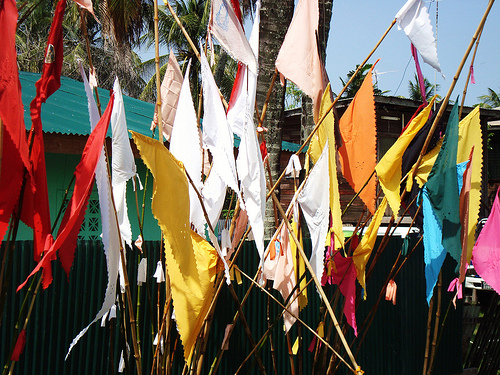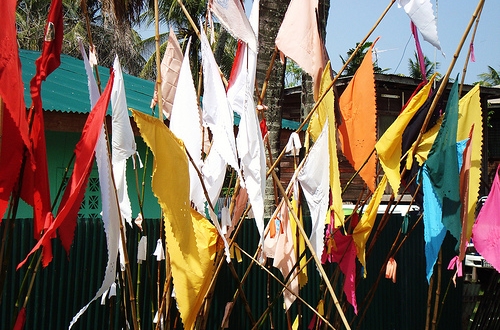Pandita Indrani Rampersad, PhD, introduces a special Vaishnava tradition followed by persons of Indian origin in Trinidad and Tobago.
Indians in the Caribbean have been undergoing rapid creolization in places like Trinidad and Tobago, where the cultural playing field has never been level because of chauvinistic ethnic based politics, and in places like St Vincent and Jamaica their numerical strength proves a disadvantage.
In the midst of creolization, one sees colourful, triangular flags flying on bamboo poles, called Jhandi-s and they are raised and planted in conjunction with Puja-s; they proliferate in rural parts of Trinidad , Guyana and Suriname, indicating pride and strength in spiritual and cultural identity. While “jhandi” also refers to pennants, flags, streamers etc, in the Caribbean, the word is used only the context of Puja.
These Jhandi-s have an immediate reference to the red Hanuman Jhanda seen at crossroads, mandir-s, trees and homes in UP/Bihar. The flags are of various colours, e.g. red, white, golden yellow, pink, yellow, blue, orange, and black. When the Indians first came to the Caribbean (between 1838 and 1917) as indentured plantation workers, they brought and planted their rich folk culture aswell. Then, only red and white jhandi-swere raised after the popular puja-s dedicated to the divinities of Hanuman, Satnarine and Surujnarine puja-s. Today, the variety of colours on the jhandi-s indicates that more pujas are dedicated to more divinities. Each deity is associated with a particular colour.

Dih Puja is peculiar to villages and it is performed to the deity, Dih, for the welfare of the village and for rich harvests. If you see a red Jhandi standing in a farm field or on the outskirts of a village, it is likely to have been raised after Dih Puja. Red is also raised for Hanuman, Durga and Kali.Agolden yellow or yellow jhandi indicates puja to the divinities of Ganesh, Vishnu and his avatars, Ganga, and Durga. A white Jhandi indicates puja to: Surujnarine, Satnarine, Saraswatti, and the Guru of the Kabir Panth.An orange flag or a blue one flies for Shiva. Lakshmi Puja is denoted by a pink flag. Kali Puja is denoted by a black and red jhandi-s; sometimes a square flag with three bands of red, white and yellow is also used for Kali Puja. The colour of the flag depends on family traditions and the deity being worshipped.
The Jhandi denotes the identity between a people, their physical and cultural landscape and the cosmos. It sanctifies domestic and community spaces, making them the centre or navel of the universe. It is the most visible and powerful Vaishnava axis mundi in Indian-Caribbean culture. The Jhandi is a misunderstood symbol in a society which boasts of a rich cultural diversity but where people really know little about each other’s spiritual world view, and particularly if those world views are of traditional Hindu and traditional African religions.
In 2001 when Prime Minister Basdeo Panday, who is a Hindu, demitted office hewas replaced by Prime Minister Patrick Manning, an evangelical Christian, who immediately removed from the Prime Minister’s residence, the Jhandi that was raised and planted by his predecessor. Well known journalist, Lennox Grant, seeking a motivation suggests that “jhandis are flags of an alien power whose invasion must be resisted.” Trinidad and Tobago (T&T) is only now getting adjusted to the idea of a Person of Indian Origin, especially a Hindu, occupying this seat of power in the country. On May 24 of this year, T&T got its first female Prime Minister, who happens to be a Person of Indian Origin and a Hindu, viz Prime Minister Kamla Persad-Bissessar.
Hindu children in one of the nation’s high schools had raised and planted their Jhandi after performing a Puja before their big exams, when certain high administrative officials demanded its removal. There was a protest and like these kinds of things in Trinidad, it died a natural death, with no policy being put in place. In T&T religious diversity is generally “tolerated” and there are many people who genuinely respect this diversity. It is not unusual to see private and government institutions celebrating Divali, for example, with deeyas, puja-s, ethnic dress and food etc., with the same fervour as they celebrate Eid and Christmas. However, there remains, as Grant suggests, a feeling that these jhandi-s are symbols of an alienpower. Caribbean Hindu Dharma is a deeply folk-oriented way of life that is transmitted via the oral tradition and this is reflected in the Jhandi which dominates the Hindu Caribbean landscape.
The Jhandi is a unique indentured diasporic symbol, signifying a unique Caribbean experience and identity with people struggling to “be themselves” amidst rapid creolization. It is the pole that connects individuals to their three worlds. This symbol of the Jhandi is likely to be dwarfed or absent in urban, elite spaces where Hindu- Caribbean people live. It remains a symbol that annually re-affirms the social and spiritual identity of a people who still remember their ancestral roots in India.
Pandita Indrani Rampersad, is Senior Research Fellow in Ramlila/Ramdilla at University of Trinidad and Tobago






